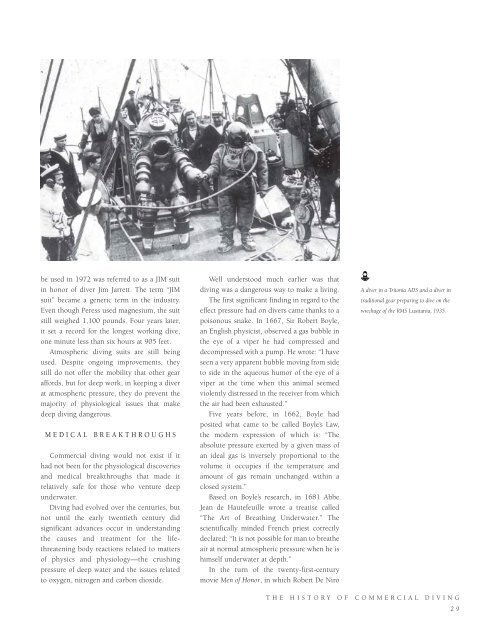Working Underwater: The Story of the Commercial Diving Industry
An illustrated history of the commercial diving industry paired with the histories of companies that have helped shape the industry.
An illustrated history of the commercial diving industry paired with the histories of companies that have helped shape the industry.
You also want an ePaper? Increase the reach of your titles
YUMPU automatically turns print PDFs into web optimized ePapers that Google loves.
e used in 1972 was referred to as a JIM suit<br />
in honor <strong>of</strong> diver Jim Jarrett. <strong>The</strong> term “JIM<br />
suit” became a generic term in <strong>the</strong> industry.<br />
Even though Peress used magnesium, <strong>the</strong> suit<br />
still weighed 1,100 pounds. Four years later,<br />
it set a record for <strong>the</strong> longest working dive,<br />
one minute less than six hours at 905 feet.<br />
Atmospheric diving suits are still being<br />
used. Despite ongoing improvements, <strong>the</strong>y<br />
still do not <strong>of</strong>fer <strong>the</strong> mobility that o<strong>the</strong>r gear<br />
affords, but for deep work, in keeping a diver<br />
at atmospheric pressure, <strong>the</strong>y do prevent <strong>the</strong><br />
majority <strong>of</strong> physiological issues that make<br />
deep diving dangerous.<br />
MEDICAL<br />
BREAKTHROUGHS<br />
<strong>Commercial</strong> diving would not exist if it<br />
had not been for <strong>the</strong> physiological discoveries<br />
and medical breakthroughs that made it<br />
relatively safe for those who venture deep<br />
underwater.<br />
<strong>Diving</strong> had evolved over <strong>the</strong> centuries, but<br />
not until <strong>the</strong> early twentieth century did<br />
significant advances occur in understanding<br />
<strong>the</strong> causes and treatment for <strong>the</strong> lifethreatening<br />
body reactions related to matters<br />
<strong>of</strong> physics and physiology—<strong>the</strong> crushing<br />
pressure <strong>of</strong> deep water and <strong>the</strong> issues related<br />
to oxygen, nitrogen and carbon dioxide.<br />
Well understood much earlier was that<br />
diving was a dangerous way to make a living.<br />
<strong>The</strong> first significant finding in regard to <strong>the</strong><br />
effect pressure had on divers came thanks to a<br />
poisonous snake. In 1667, Sir Robert Boyle,<br />
an English physicist, observed a gas bubble in<br />
<strong>the</strong> eye <strong>of</strong> a viper he had compressed and<br />
decompressed with a pump. He wrote: “I have<br />
seen a very apparent bubble moving from side<br />
to side in <strong>the</strong> aqueous humor <strong>of</strong> <strong>the</strong> eye <strong>of</strong> a<br />
viper at <strong>the</strong> time when this animal seemed<br />
violently distressed in <strong>the</strong> receiver from which<br />
<strong>the</strong> air had been exhausted.”<br />
Five years before, in 1662, Boyle had<br />
posited what came to be called Boyle’s Law,<br />
<strong>the</strong> modern expression <strong>of</strong> which is: “<strong>The</strong><br />
absolute pressure exerted by a given mass <strong>of</strong><br />
an ideal gas is inversely proportional to <strong>the</strong><br />
volume it occupies if <strong>the</strong> temperature and<br />
amount <strong>of</strong> gas remain unchanged within a<br />
closed system.”<br />
Based on Boyle’s research, in 1681 Abbe<br />
Jean de Hautefeuille wrote a treatise called<br />
“<strong>The</strong> Art <strong>of</strong> Breathing <strong>Underwater</strong>.” <strong>The</strong><br />
scientifically minded French priest correctly<br />
declared: “It is not possible for man to brea<strong>the</strong><br />
air at normal atmospheric pressure when he is<br />
himself underwater at depth.”<br />
In <strong>the</strong> turn <strong>of</strong> <strong>the</strong> twenty-first-century<br />
movie Men <strong>of</strong> Honor, in which Robert De Niro<br />
A diver in a Tritonia ADS and a diver in<br />
traditional gear preparing to dive on <strong>the</strong><br />
wreckage <strong>of</strong> <strong>the</strong> RMS Lusitania, 1935.<br />
THE HISTORY OF COMMERCIAL DIVING<br />
29
















